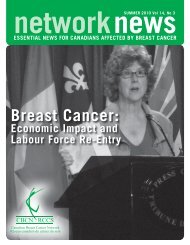Report Card on Wait Times in Canada
Report Card on Wait Times in Canada
Report Card on Wait Times in Canada
Create successful ePaper yourself
Turn your PDF publications into a flip-book with our unique Google optimized e-Paper software.
A <str<strong>on</strong>g>Report</str<strong>on</strong>g> <str<strong>on</strong>g>Card</str<strong>on</strong>g> <strong>on</strong> <strong>Wait</strong> <strong>Times</strong> <strong>in</strong> <strong>Canada</strong> 2012<br />
Before a patient receives medical treatment, there are<br />
three prelim<strong>in</strong>ary stages to the wait-time c<strong>on</strong>t<strong>in</strong>uum: 1) f<strong>in</strong>d<strong>in</strong>g<br />
a family physician; 2) be<strong>in</strong>g seen by your family<br />
physician; 3) diagnostic <strong>in</strong>terventi<strong>on</strong> or be<strong>in</strong>g seen by a c<strong>on</strong>sult<strong>in</strong>g<br />
specialist. Just over four milli<strong>on</strong> Canadians do not<br />
have a family doctor. 5 These “orphan” patients often seek care<br />
from walk-<strong>in</strong> cl<strong>in</strong>ics and emergency rooms.<br />
For those with their own family doctor, there may be<br />
problems obta<strong>in</strong><strong>in</strong>g timely care. Timely access is rated by<br />
patients as <strong>on</strong>e of the most important elements of primary<br />
care. 6 Yet accord<strong>in</strong>g to <strong>in</strong>ternati<strong>on</strong>al studies, <strong>on</strong>ly 17% of primary<br />
care practices <strong>in</strong> <strong>Canada</strong> offer patients same- or<br />
next-day appo<strong>in</strong>tments and <strong>Canada</strong> placed fifth out of seven<br />
nati<strong>on</strong>s with respect to patients be<strong>in</strong>g able to access care <strong>on</strong><br />
nights or weekends. 7<br />
One of the most problematic access-to-care po<strong>in</strong>ts <strong>in</strong><br />
the wait-time c<strong>on</strong>t<strong>in</strong>uum identified by the Primary Care<br />
<strong>Wait</strong> Time Partnership of the CFPC and the CMA<br />
(Canadian Medical Associati<strong>on</strong>) is the wait experienced<br />
by patients who are referred by their family physician to<br />
appo<strong>in</strong>tments with other specialists or specialty services. 8<br />
There are likely a myriad of reas<strong>on</strong>s for these referral<br />
waits, such as a dim<strong>in</strong>ished role for family physicians <strong>in</strong><br />
hospitals, which may have lessened communicati<strong>on</strong><br />
between family physicians and other specialists. 9<br />
Improv<strong>in</strong>g access to care is the most critical step we can<br />
take to address wait times. Timely access not <strong>on</strong>ly emphasizes<br />
patient-centredness, it can “reduce redundancy and<br />
duplicati<strong>on</strong> of services (e.g., when a patient accepts and<br />
keeps a later appo<strong>in</strong>tment but also c<strong>on</strong>sults another<br />
provider <strong>in</strong> the <strong>in</strong>terim), improve health outcomes,<br />
achieve better patient and provider satisfacti<strong>on</strong>, and lead<br />
to a reducti<strong>on</strong> <strong>in</strong> emergency visits.” 10 There is an opportunity<br />
for other specialists to become <strong>in</strong>volved with family<br />
physicians <strong>in</strong> new approaches to access to care that would<br />
benefit patients. These <strong>in</strong>clude participati<strong>on</strong> with family<br />
physicians <strong>in</strong> Patient’s Medical Home practice models, 11<br />
<strong>in</strong>volvement with family doctors <strong>in</strong> shared care <strong>in</strong> def<strong>in</strong>ed<br />
cl<strong>in</strong>ical areas, and advanced access book<strong>in</strong>g for c<strong>on</strong>sultati<strong>on</strong>s<br />
similar to the approaches be<strong>in</strong>g advocated for<br />
appo<strong>in</strong>tments with a family physician.<br />
The CFPC’s Patient’s Medical Home seeks to address the<br />
whole wait time experienced by patients for appo<strong>in</strong>tments<br />
with both their family doctors, as well as the waits encountered<br />
<strong>in</strong> the referral-c<strong>on</strong>sultati<strong>on</strong> process. With better access<br />
and care centred <strong>on</strong> the patient, Patient Medical Homes will<br />
help to achieve better health outcomes for each pers<strong>on</strong>, practice<br />
populati<strong>on</strong> and community be<strong>in</strong>g served.<br />
<strong>Wait</strong> times for specialist referrals<br />
Currently, we know little about how l<strong>on</strong>g patients wait to<br />
be seen by a c<strong>on</strong>sult<strong>in</strong>g specialist. Until recently, very few<br />
prov<strong>in</strong>ce-wide efforts were underway to capture this data.<br />
Those sources that do exist suggest the wait for a c<strong>on</strong>sultati<strong>on</strong><br />
is just as problematic as the wait to receive a<br />
procedure. One <strong>in</strong>ternati<strong>on</strong>al survey of 11 lead<strong>in</strong>g <strong>in</strong>dustrialized<br />
countries found that <strong>Canada</strong> ranked 10th <strong>in</strong> terms of<br />
the percentage of “sicker adults” be<strong>in</strong>g able to see a specialist<br />
with<strong>in</strong> a m<strong>on</strong>th (52% <strong>in</strong> <strong>Canada</strong> compared to 92% <strong>in</strong><br />
Switzerland). 12 A 2011 survey of Canadian family physicians<br />
found that the most difficult specialties to access for<br />
their patients were: orthopedics; ear, nose and throat; gastroenterology;<br />
psychiatry; and neurology. “L<strong>on</strong>g wait<br />
times” was the most frequently identified reas<strong>on</strong> for these<br />
problems. 13<br />
In April 2012, nearly 200 gastroenterologists participated<br />
<strong>in</strong> the third nati<strong>on</strong>al survey of wait times for digestive care.<br />
Carried out by the Canadian Associati<strong>on</strong> of Gastroenterology<br />
(CAG) dur<strong>in</strong>g the week of April 16, the survey sheds more<br />
light <strong>on</strong> the issue of wait times for specialist referrals.<br />
Participat<strong>in</strong>g physicians were asked to provide wait-time<br />
data <strong>on</strong> five new patients seen <strong>in</strong> c<strong>on</strong>sultati<strong>on</strong> and five<br />
patients scheduled for <strong>in</strong>vestigati<strong>on</strong>. Hav<strong>in</strong>g performed similar<br />
wait-time assessments <strong>in</strong> 2005 and 2008, the CAG can<br />
plot trends <strong>in</strong> access to digestive care over a seven-year period.<br />
In its recent survey, data were obta<strong>in</strong>ed <strong>on</strong> nearly 2,000<br />
patient <strong>in</strong>teracti<strong>on</strong>s with the health system. Data for six <strong>in</strong>dicati<strong>on</strong>s<br />
are provided <strong>in</strong> Table 2.<br />
For example, the total wait time for a patient with a high<br />
likelihood of severe IBD is 126 days, which is 112 days<br />
l<strong>on</strong>ger than the target wait time. This total wait time for care<br />
is made up of a median wait for c<strong>on</strong>sultati<strong>on</strong> of 72 days and<br />
then another wait for diagnostic test<strong>in</strong>g of 44 days. These are<br />
patients with pa<strong>in</strong> and bloody diarrhea, who are often unable<br />
to work or can <strong>on</strong>ly do so with difficulty. Analysis of total<br />
wait times <strong>in</strong>dicates that the Canadian total wait time, c<strong>on</strong>sider<strong>in</strong>g<br />
all gastroenterology <strong>in</strong>dicati<strong>on</strong>s, has progressively<br />
<strong>in</strong>creased from 2005–2012 and is now 30 days l<strong>on</strong>ger than <strong>in</strong><br />
2005. These results are of c<strong>on</strong>cern and <strong>in</strong>dicate a need to pursue<br />
strategies that will ensure that patients receive the care<br />
they need <strong>in</strong> a timely manner.<br />
6














